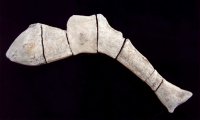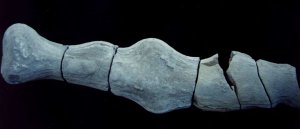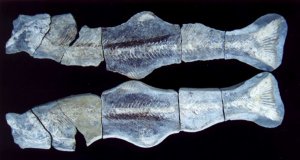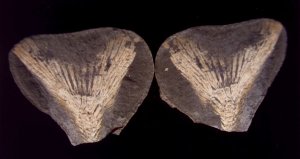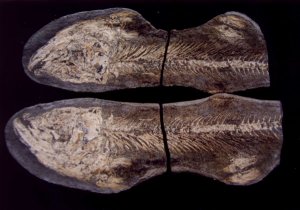 |
|||
|
|||
|
Copyright
Oncorhynchus nerka (Salmon)
My first reaction beside amazement was "Where did you find this rock?" My son's casual reply, "Oh, just over the railroad tracks, there are piles of them laying around". Without a moment of hesitation I was up and over the tracks as fast as my feet could carry me, and sure enough there they were scattered around all over the place. We couldn't pick them up and split them open fast enough. Then I realized that these fossils should not be split open in the field - that pleasure should wait until you get home. Careful identification procedures were used without the loss of any valuable pieces at home. That night we split open approximately twelve salmon, but who was really counting. We had salmon heads, salmon dorsal fins, salmon tails every piece of a salmon you could think of and I can thank it all to that dog, Nick, the black lab that would not chase a rock.
Fig 3. Split fossil. Size: 20 1/2" L x 5 1/4" W at the head
Just as I was looking up the face to see how far the climb would be to the top, there were the salmon. There lying on their sides, length-wise, half-embedded in the hard clay just as the previous salmon pieces were trapped in. With more patience than I ever knew I had, we ever so gently removed the hard clay that trapped these salmon for thousands of years. The first one extracted was one my son was working on patiently for about 2 hours. Finally, it came loose in his hands. It was a complete fossilized salmon broken in only four places, but still complete and unsplit. This prize measured 21" long from head to tail and shaped as though it just jumped out of the water in a perfect arch (see Figure 1). Digging now at a feverish pace, we unearthed another three salmon - completely intact and ranging in size from 15" to 20" (Figures 2-6).
Fig 6. Split. Size: 20 1/2" L x 5 1/4" W at the head.
As the winter progressed we did manage to get out to the site several more times and were never skunked. There was always a head, tail or a dorsal fin to be found (see Figures 7-9 below), and yes, another whole salmon or two were found. However, as winter dragged on we found less and less but felt the cold more and more. We made a few trips to the dig this past summer, but did not find anything exciting. However, you never know what you might find in the next overturned shovelfull of clay, or what's around the next inlet along the shores of Kamloops Lake. Similar FindingsSimilar salmon fossils were found, and identified as Oncorhynchus nerka in the 1970's by the late Richard Hughes (geologist and paleontologist) near the same area that Paul and I first discovered them. However, none compare to the complete salmon fossils we found. A whole and complete specimen has never been found in North America previously!Thankfully, professor Ken Klein of the University College of the Cariboo in Kamloops, B.C. recently found similar salmon fossils in the area and had them carbon-dated between 15,480 and 18,110 years old.
Fig 7. Split. Size: 13 3/8" L x 3 1/2" W at the head.
Fig 8. Tail, split. Size: 3 3/8" W x 3 1/8" L.
Fig 9. Head and dorsal, split.
Reference
This article may not be copied, distributed or reprinted in any form without the author's permission. To contact the author, please use the e-mail address provided. If you are unable to contact the author, please contact the Canadian Rockhound. Authorized reprints must acknowledge the author and the Canadian Rockhound, and include the website URL address of the Canadian Rockhound.
|
||||||||||

Copyright © 1999 Canadian Rockhound
Magazine Issues |
News & Events |
Junior Rockhound |
Resources
|
||||||||||
 Salmon fossils.
Salmon fossils.
